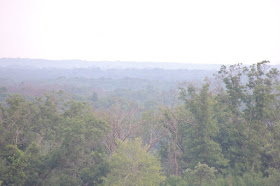Raymond Noyes barn. Raymond passed away about 2003 at age 80. He grew up on the farm across the road from the Hanson farm. Struck with polio as a youngster, he had a hand and leg that never worked right and were bent. A limp, special shoe, difficult hand made things hard for him, but he never spared himself hard work. When WWII began, he was too disabled to be drafted. He wanted to have his own farm, so went to work in the Twin Cities--a munitions plant I think, and earned money to buy the 80 acres just south of the Hanson farm, the Axel and Anna Ranstrom farm. He didn't move there, but built this new barn with his earnings shortly after the war was over. His mother, Inez Armstrong died in 1951. He and his father lived on the home place across the road from us, and they hired Anna Ranstrom, a widow by then, to come each day and cook, clean, can and run the household. She lived in the house at Raymond's farm. Raymond didn't marry until he was in his 60s, had no siblings and no children. Having the 4 Hanson boys across the road, all versed in farming, Leonard and Raymond hired us to help with farming. Leonard passed away from cancer in 1959 (I was 13 and had been helping with haying and driving their B John Deere for two years by that time). The barn has a sheet of tin gone, the haymow door is tipping in, but if someone put just a little work into it, the barn would be good for another 30 years. My guess is the barn was built about 1951-1953 based on the cinder block walls. That was the same time Dad removed the wooden base of his barn and replaced it with these blue blocks made from the cinders of coal burned on the railroad or power plants. The galvanized tin of that era was much better made than nowadays (it is surely 60 years old).
I remember climbing into the haymow to throw down some hay to feed the cows and grabbing a wooden ladder step nailed between the studs, it coming loose and me falling to the concrete floor below (padded with a little hay) and cracking several ribs. Painful for the next months and put an end to my summer work.
Raymond, possibly because of his being crippled (the word used in those days) didn't marry. He was a very hard worker and ignored his disability. However, I think it made him bitter, and as he grew older, rarely had anything good to say about anything -- politics, schools, people, etc. His main joy in life was farming, especially running a combine. He had spent some time in ND working and ran a self propelled combine there, and bought a small one here, than a larger one and enjoyed the grain harvest tremendously.
Raymond was not afraid to try making his own machinery. He built his own wood elevator, a concrete mixer, a camper, and a wide front for his John Deere so he wouldn't drive on the grain row as he pulled the swather. I remember using it -- Model A front end that bolted under the front of the John Deere. The only problem was the steering was the opposite direction, so you had to get used to turning left when you wanted to go right -- not terrible unless you got in a tight corner and under stress! The elevator, cement mixer and camper all worked, but they were overbuilt -- big and clunky but serviceable. The camper was a trailer with about a 3-foot top-- you opened the door and sort of crawled in and slept in a bunk -- no room to stand up or hardly kneel, but it was his way of saving the cost of a motel room.
Leonard and Raymond and Inez liked to travel. I remember how envious I was of their old Mercury car (their favorite brand)-- the back side windows covered with decals from all the states they had been in. This was back in 1950 when travel was still an adventure. |













